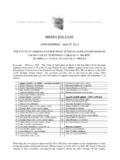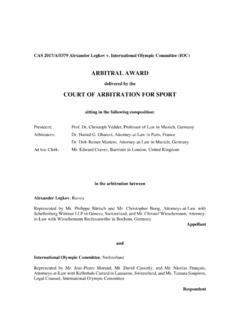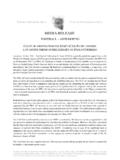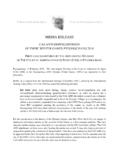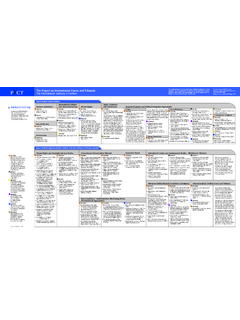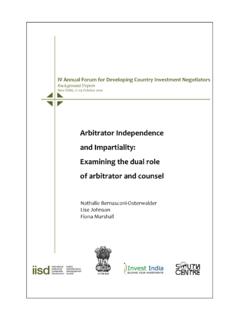Transcription of ARBITRAL AWARD COURT OF ARBITRATION FOR …
1 CAS 2017/O/5039 International Association of Athletics Federation (IAAF) v. Russian Athletic Federation (RUSAF) & Anna Pyatykh ARBITRAL AWARD rendered by COURT OF ARBITRATION FOR SPORT sitting in the following composition Panel: Prof. Jens Evald, Professor, Aarhus, Denmark, Sole Arbitrator in the ARBITRATION between: INTERNATIONAL ASSOCIATIONS OF ATHLETICS FEDERATIONS (IAAF), Monaco Represented by Mr Ross Wenzel and Nicolas Zbinden, Attorneys-at-Law, Kellerhals Carrard, Lausanne Switzerland Claimant v. 1/ THE RUSSIAN ATHLETICS FEDERATION (RUSAF), Moscow, Russian Federation First Respondent and 2/ Ms ANNA PYATYKH, Russian Federation Second Respondent CAS 2017/O/5039 International Association of Athletics Federation (IAAF) v. Russian Athletic Federation (RUSAF) & Anna Pyatykh Page 2 I. PARTIES 1. The International Association of Athletics Federations (the Claimant or the IAAF ) is the world governing body for the sport of Athletics, established for an indefinite period with legal status as an association under the laws of Monaco.
2 The IAAF has its registered seat in Monaco. 2. The Russian Athletic Federation (the First Respondent or the RUSAF ) is the national governing body for the sport of Athletics in the Russian Federation, with its registered seat in Moscow, Russian Federation. The RUSAF is a member federation of the IAAF for Russia, currently suspended from membership. 3. Ms Anna Pyatykh (the Second Respondent or the Athlete ) is a Russian athlete specializing in triple jump. She is an International-Level Athlete for the purposes of the IAAF Competition Rules (the IAAF RULES ). II. FACTUAL BACKGROUND 4. Below is a summary of the main relevant facts, as established on the basis of the parties written and oral submissions and the evidence examined in the course of the present ARBITRATION proceedings and during the hearing. This background is set out for the sole purpose of providing a synopsis of the matter in dispute.
3 Additional facts may be set out, where relevant, in connection with the legal discussion that follows. While the Sole Arbitrator has considered all the facts, allegations, legal arguments and evidence submitted by the parties in the present proceedings, he refers in his AWARD only to the submissions and evidence he considers necessary to explain his reasoning. 5. This case concerns a claim by the IAAF against the Second Respondent for violating Rule (a) of the 2007 IAAF Rules (Presence of a Prohibited Substance or its Metabolites or Markers in an Athlete s Sample) and Rule (b) of the 2013 IAAF Rules (Use or Attempted Use by an Athlete of a Prohibited Substance or a Prohibited Method). The RUSAF has been included in the claim as the First Respondent, as the RUSAF has not been able to conduct the hearing process due to its suspension. 6. Two distinct sets of facts amount to separate anti-doping rule violations (the ADRV ): (A) a retesting of a sample collected in 2007 (the Retesting Allegation ) and (B) the Moscow washout testing as described in the Richard H.
4 McLaren, Independent Person reports of 16 July 2016 (the First IP Report ) and of 9 December 2016 (the Second IP Report ) and the underlying evidence (the Washout Allegation ). Each set of facts will be described separately. 7. (A) the Retesting Allegation: 8. The Athlete underwent doping test at the 11th IAAF World Championships in Osaka (Japan) on 31 August 2007. The sample was analyzed shortly after the doping control and did not reveal the presence of any prohibited substance. CAS 2017/O/5039 International Association of Athletics Federation (IAAF) v. Russian Athletic Federation (RUSAF) & Anna Pyatykh Page 3 9. At the request of the IAAF, the Athlete s sample was transferred for long-term storage to the WADA-accredited laboratory of Lausanne (Switzerland). 10. On 19 October 2016, the IAAF requested the Lausanne laboratory to carry out further analyses on the Athlete s sample. These analyses revealed the presence of Dehydrochlormethyltestosterone ( DHCMT ) metabolites.
5 DHCMT is an Exogenous Androgenic Anabolic Steroid, prohibited under section of the World Anti-Doping Agency (the WADA ) Prohibited List. 11. On 5 December 2016, the IAAF notified the Athlete of the ADRV, informing her in particular of her right to provide explanations for the Adverse Analytical Finding (the AAF ) and to request the analysis of the B-sample and/or provision of the A sample Laboratory Documentation Package. 12. On 15 December 2016, having not received any reply from the Athlete, the IAAF provisionally suspended her and informed her of her right to request a hearing within 14 days, to be held before CAS in view of RUSAF s suspension. The Athlete was given the choice of having her case heard either by a Sole Arbitrator as a first instance panel pursuant to Rule of the IAAF Rules or by a CAS Panel as a sole instance. 13. By email dated 16 December 2016, the Athlete provided her explanations for the AAF.
6 According to her explanations, the positive result came from supplements that she had been taking. In her letter, she requested her case to be heard by a Sole Arbitrator as first instance and, inter alia, explained the following: One of them, with conceivably beneficial effect for training sessions, was Laxodrol, manufactured by Ergogen Labs. The product containing, with reference to the product description, exceptionally natural, plant steroid, called 5a-hydroxy Laxogenin. After a while, when I had run out of laxodrol, I regained the consumption of another 5a-hydroxy Laxogenin containing dietary supplement made by Xcel Sports nutrition, namely Natural Strength. Besides, as far as I recollect, I was consuming a large quantity of another products manufactured by Xcel Sports nutrition Crackhead Xtreme, Pre-Workout and Ultimate BCAA. [..] In addition, as far as I strongly remember, I d been consuming NANO VAPOR Pre-Workout and Nitro-Tech Performance dietary supplements, manufactured by Muscle Tech.
7 At present moment, certainly, my assumptions are based on guesses about those sport nutritional products that had been designed to be merely dietary supplements, but apparently they hadn t since they gave rise to an adverse analytical finding. 14. On 23 December 2016, the IAAF informed the Athlete that the explanation that she had provided was not adequate, that she therefore remained suspended and that her case would, as requested, be referred to CAS in accordance with Rule of the IAAF Rules. CAS 2017/O/5039 International Association of Athletics Federation (IAAF) v. Russian Athletic Federation (RUSAF) & Anna Pyatykh Page 4 15. (B) the Washout Allegations: 16. On 16 July 2016, Prof. Richard H. McLaren (the Independent Person or IP ) issued the First IP Report on allegations of systematic doping in Russia. 17. The key findings of the First IP Report are the following: The Moscow Laboratory operated, for the protection of doped Russian athletes, within a State-dictated failsafe system, described in the report as the Disappearing Positive Methodology.
8 The Sochi Laboratory operated a unique sample swapping methodology to enable doped Russian athletes to compete at the Games. The Ministry of Sport directed, controlled and oversaw the manipulation of athlete s analytical results or sample swapping, with the active participation and assistance of the Russian Federal Security Service (the FSB ), the Center of Sports Preparation of National Teams of Russia (the CSP ) and both Moscow and Sochi Laboratories. 18. On 9 December 2016, the IP confirmed the key findings of the First IP Report (page 2 of the Second IP Report). In the Second IP Report, the IP described the so-called washout testing prior to certain major events, including the 2012 London Olympic Games and the 2013 IAAF World Championships in Moscow. 19. The washout testing started in 2012, when Dr. Rodchenkov developed a secret cocktail called the Duchess with a very short detection window (page 23 of the Second IP Report).
9 In the Second IP Report is stated, that this process of pre competition testing to monitor if a dirty athlete would test clean at an upcoming competition is known as washout testing (see page 71 of the Second IP Report). 20. The washout testing was used to determine whether the athletes on a doping program were likely to test positive at the 2012 London Olympic Games (see pages 71-78). At that time the relevant athletes were providing samples in official doping control Bereg Kits. While the Laboratory s initial testing procedure ( ITP ), which show the presence of Prohibited Substances, were recorded on the washout list, the samples were automatically reported as negative in the Anti-Doping Administration and Management System ( ADAMS ) (see page 72 of the Second IP Report). 21. As a result of this testing program, there were no positive Russian analytical results at the 2012 London Olympic Games, although 11 Russian athletes were retested positive at the time of the Second IP Report (see page 24 of the Second IP Report).
10 22. The covering up of falsified ADAMS information only worked if the sample stayed within the control of the Moscow Laboratory, and later destroyed. Given that Bereg kits are numbered and can be audited or also seized and tested the Moscow Laboratory realized that CAS 2017/O/5039 International Association of Athletics Federation (IAAF) v. Russian Athletic Federation (RUSAF) & Anna Pyatykh Page 5 it would be only a matter of time before it was uncovered that the content of samples bottle would not match the entry into ADAMS (see page 72 of the Second IP Report). 23. Therefore, the washout testing program evolved prior to the 2013 IAAF World Championships in Moscow. It was decided that the washout testing would no longer be performed with official Bereg kits, but from containers selected by athletes, such as Coke and baby bottles filled with their urine. The athlete s name would be written on the selected container to identify his or her sample (see page 85 of the Second IP Report).

